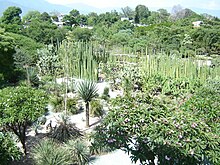Jardín Etnobotánico de Oaxaca
The Oaxaca Ethnobotanical Garden ( Ethno Botanical Garden) is located behind the former convent of Santo Domingo de Guzmán in the historic center of Oaxaca City in Mexico , which since 1987 the UNESCO - World Heritage belongs. The plants have been planted since July 1998.
layout
The garden displays hundreds of plant species, all of which can be found in the state of Oaxaca . The plants come from different regions of the state, from both dry and humid climates, from the tropical low coastal region, and the mountainous, temperate and cold areas. The garden thus presents the great variety of climatic and geological conditions and types of vegetation that characterize Oaxaca.
The main aim of this botanical garden is to show the lively relationships between the vegetation and the cultures of the state. Oaxaca is the state where more ethnic groups live and more native languages are spoken than any other Mexican state. Many of the native plants have given the people of Oaxaca aesthetic and intellectual stimulation throughout their twelve thousand year cultural history. Apart from that, they are still used today as food, firewood, clothing fiber, medicine, spice or dye.
In addition to collecting, caring for and protecting the plants, the garden also does storage, education and research work. There is a seed bank, a herbarium and a specialized library where the public can consult information about the flora, vegetation, ecology, history and ethnobiology. The shapes, colors and textures of the plants that grow in the garden are in harmony with the architecture of the Santo Domingo Monastery, which was built with green stones. The water flowing along a canal leads visitors through the whole garden.
division
The garden is divided into the following thematic areas:
- Bushes and coppice
- Tropical dry forests
- Tropical moist forests
- Mountain forests
- Orchards and vegetable gardens, as well as parks
- Forests of the valley of Oaxaca
- Art related plants of Oaxaca
- Crops
- Medicinal plants
A section of the garden is also specifically dedicated to the species that grow in Guilá Naquitz , a cave near Mitla . Archaeologists have found remains of plants that are thousands of years old. Among these were cultivated pumpkin seeds indicating early agriculture. The oldest remains of maize (around seven thousand years old) found to date were found in the same cave.
history
The Santo Domingo Monastery was built for Dominican monks in the 16th and 17th centuries. The monks reportedly used the garden as a fruit and vegetable growing area for the monastery.
From the mid-19th century to 1994, the garden served as barracks for soldiers stationed in Oaxaca and was characterized by bedrooms, parks, athletic playgrounds and other military facilities.
Institutional structure
The garden was created on the initiative of the artist Francisco Toledo and the civil association PRO-OAX (Patronage for the Defense and Preservation of the Cultural and Natural Heritage of Oaxaca, AC). In 1994 the botanical garden was established with the participation of the state government, Banamex (National Bank of Mexico) and PRO-OAX. The institute has received additional aid from the state Department of Culture and the Arts and the National Institute of Anthropology and History.
Data
- Total area of the garden: 2.32 hectares
- Currently planted area: 2.10 hectares
- Number of species currently planted: more than 1,400
- Communities and cultural groups that helped adapt the garden: more than 100
literature
- Michael Heinrich: Ethnobotany of the lowland mixes (Oaxaca, Mexico) and phytochemical analysis of Capraria biflora L. (Scrophulariaceae). Publisher: Borntraeger (1989), ISBN 978-3-443-64053-8
- Walter Egli: San Pedro Amuzgos - A Mexican Indian village is fighting for its land. Agricultural history of the Costa of Oaxaca from colonial times to the present. ISBN 978-3-85791-059-3
- Thomas W. Whitaker: Pre-historic Cucurbits from the Valley of Oaxaca.
- Marta Guidi: Estigma y Prestigio. La Tradición de Migrar en San Juan Mixtepec (Oaxaca, México). ISBN 978-3-86097-064-5
- Alejandro de Avila Blomberg, Cecilia Salcedo (2006): La espina y el fruto - Plantas del Jardin Etnobotanico de Oaxaca, The Thorn and the Fruit - Plants from the Ethnobotanical Garden of Oaxaca (bilingual). Artes de Mexico: ISBN 970-683-157-6 , Consejo Nacional para la Cultura y las Artes: ISBN 970-35-1010-8
Web links
- Description of the garden in the BGCI (Spanish)
- Page of the associated library (Spanish) ( Memento from January 5, 2009 in the Internet Archive )
- Report by Jill Nokes
- Position in GoogleMaps
- Botanical Gardens Information System
- Spanish Wikipedia on the Templo de Santo Domingo
Coordinates: 17 ° 3 '59.6 " N , 96 ° 43' 21.1" W.



